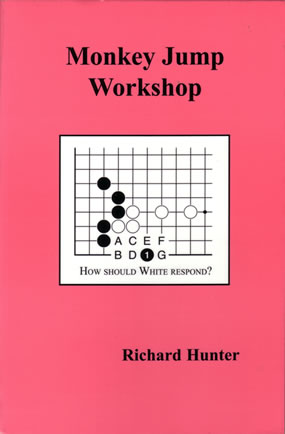Monkey Jump Workshop
BGJ 127 Summer 2002
Reviewer: Simon Goss
ISBN 0-9706193- 9-1
When was the last time you (a) played a monkey jump and it was cut off and killed? (b) played a monkey jump and ended in gote? (c) answered a monkey jump the wrong way and saw 20 points knocked off your territory? (d) thought that a monkey jump was the answer to a life and death problem and then turned the page and learned that it could refuted? (e) thought that a monkey jump wasn’t the answer to a life and death problem and then found that it was? Monkey Jumps are among the most common things to occur in actual games, and most of us have experienced these frustrations several times in our Go careers.

Richard Hunter’s Monkey Jump Workshop is a comprehensive study of the monkey jump as both an endgame and a life-and-death tesuji. In part, it’s a reprint of the series Richard wrote for this Journal during the 1990s, but greatly expanded with the addition of new text, more problems, and a large collection of professional games.
The book has 144 pages. Slightly more than half of it deals with endgame sequences. It begins by establishing the most common sequence as a reference point, explaining the meaning of each move. It then goes on to show how the arrangement of the surrounding stones can affect matters and how to choose the most appropriate line in each case. On the way, there are several warnings about errors elsewhere in the literature.
Among the reasons why one sequence can be better than another is when they are worth a different number of points, so it would be impossible to deal with this subject without counting the values of the moves. Richard has taken great care to do this in a way that will be accessible to most readers. Anyone who has read the counting chapters in Basic Techniques of Go or The Endgame will have no trouble at all. In fact, I suspect that many people who have not read anything like that will cope quite easily and may find Richard’s approach to be a useful introduction to the subject.
The treatment of life-and-death situations is shorter. It deals with: spotting when a monkey jump may be a killing move; a standard technique for defending against it (different from the sequences used to block an incursion into territory); and how to choose between attacking a group with the large and small knight’s moves.
The book includes 16 endgame problems and 39 life and death problems, ranging in difficulty from basic review of the ideas introduced through to the challenge that Takemiya faced when he wanted to kill a big group of Sakata’s. It concludes with a collection of 19 uncommented games played by top-ranking Japanese professionals over the last 40 years.
Monkey Jump Workshop is published by Slate & Shell.
If you have any comments, please email the webmaster on web-master AT britgo DOT org.
